|
|
|
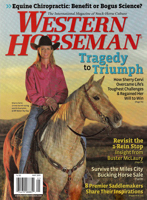
Last Stockman
on the
Turquoise Trail
Story and Photography by Tim Keller
Western Horseman, May 2009
The original typescript follows the magazine pages, for easier reading.
Look below, too, for more pictures and an additional article.
|
|
|
|
|
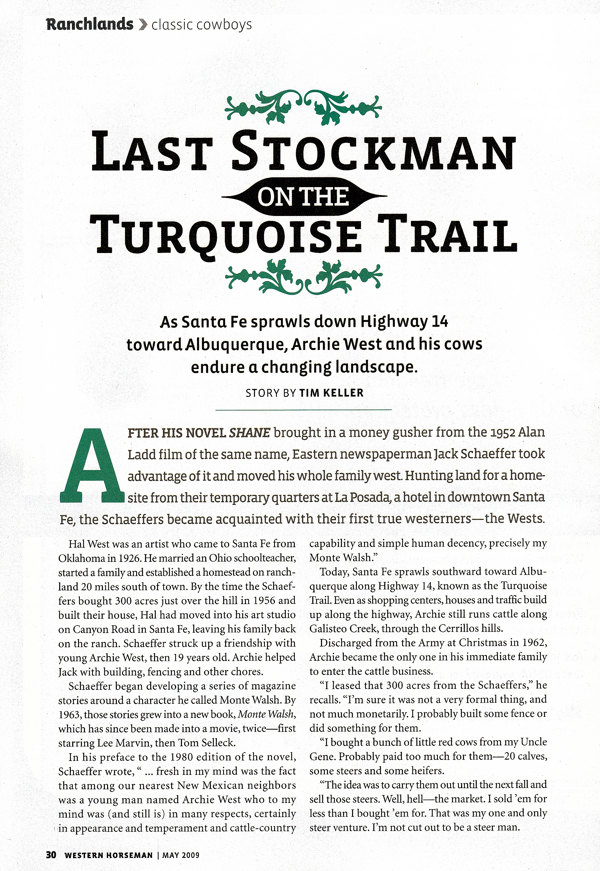
|
|
|
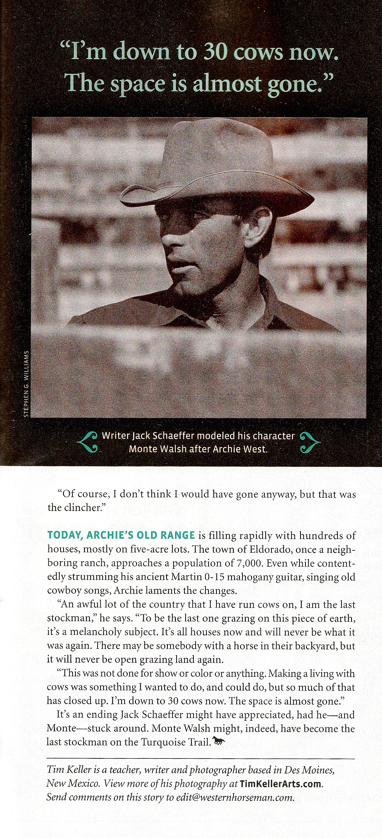 |
|
|
| Vintage 40-year-old photos by Stephen Guion Williams |
| |
| * View or purchase a print of Tim's Western Horseman portrait of Archie * |
| |
| More photographs: Archie's Kitchen Archie's Hat Archie's Living Room |
|
| Leave a comment? |
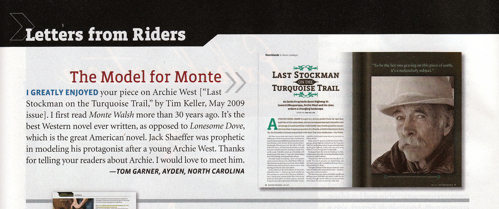
Western Horseman, July 2009 (click to enlarge)
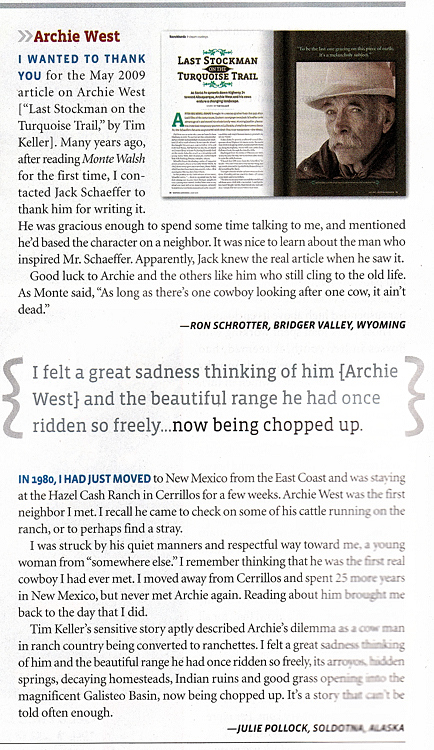
Western Horseman, August 2009
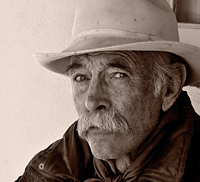
Look closer at Tim's award-winning portrait of Archie West
|
Here's the original typescript as submitted
(and below that, another article on Archie): |
|
ARCHIE WEST
The Last Stockman on the Turquoise Trail
Story and Photography by Tim Keller
After his novel Shane brought in a money gusher from the 1952 Alan Ladd film of the same name, eastern newspaperman Jack Schaeffer took advantage and moved his whole family out west. Hunting land for a homesite from their temporary quarters at La Posada, a hotel in downtown Santa Fe, the Schaeffers became acquainted with their first true westerners...the Wests.
Artist Hal West came to Santa Fe from Oklahoma in 1926. He married an Ohio schoolteacher, started a family, and established a homestead on ranchland 20 miles south of town. By the time the Schaeffers, in 1956, bought 300 acres and built their house just over the hill, Hal West had moved into his art studio on Canyon Road, leaving his family back on the ranch. Jack Schaeffer struck up a friendship with young Archie West, then 19 years old. Archie helped Jack with building, fencing, and other chores.
Schaeffer began developing a series of magazine stories around a character he called Monte Walsh. By 1963 these stories grew into a new book, Monte Walsh, which has since been made into a movie, twice -- first starring Lee Marvin, then Tom Sellack. In his preface to the 1980 edition of the novel, Schaeffer wrote, “...fresh in my mind was the fact that among our nearest New Mexican neighbors was a young man named Archie West who to my mind was (and still is) in many respects, certainly in appearance and temperament and cattle-country capability and simple human decency, precisely my Monte Walsh.”
In 2009, even as Santa Fe sprawls southward toward Albuquerque along Highway 14, “The Turquoise Trail”, Archie West is still running cattle along Galisteo Creek through the Cerrillos hills. He’s the last one.
Discharged from the Army at Christmas, 1962, Archie became the only one in his immediate family to enter the cattle business. “I leased that 300 acres from the Schaeffers,” he recalls. “I’m sure it was not a very formal thing, and not much monetary. I probably built some fence or did something for them. I bought a bunch of little red cows from my Uncle Gene. Probably paid too much for them – twenty calves, some steers and some heifers.
“The idea was to carry them out until the next fall and sell those steers. Well, hell, the market: I sold ‘em for less than I bought ‘em for. That was my one and only steer venture. I’m not cut out to be a steer man. Now a cow’ll make you some money, you’ll never lose, but steers is like playing a slot machine. You got the weather and the market. You can make a lot, or you can lose it all.”
When his cousin moved to Wyoming in 1965, Archie took out an FHA loan to buy his cousin’s stock, bringing Archie’s holdings to the highest they’ve ever been, just over 100 head of cattle. “I’ve never bought another cow. It’s been what they call a cow-calf operation. I keep the heifers to replace the cows that drop off when they get too old to be productive. I haven’t bought a calf since 1965.”
Recalling those early years, Archie says, “Before I married, the cows were paying their way and I was able to make what money I needed, which wasn’t a heck of a lot. And I broke horses and worked on ranches, day work. I wasn’t a full-time employee, but a lot of that work went on for months.” He worked his own small herd, setting out on horseback from the house he’s occupied since 1943, near Lone Butte, ranging south to the town of Cerrillos, and west almost to Interstate-25 south of La Cienega. Fences were few, his cattle spread over a radius of 12 miles.
This was the classic west. Three movie ranches sprang up where countless dozens of westerns have been filmed from the 1960s to the present. But as the fences spread, Archie’s leased pastures grew progressively smaller. Today he usually leaves his horses home, driving his 1982 Chevy four-wheel-drive pickup to tend the remaining cows east of Cerrillos.
He can’t imagine using an ATV. “No, no, this country may be 4-wheelable, but there’s a lot of it you just couldn’t get through, deep long arroyos. I’ve never ridden one enough to know, but I see no advantage to it. Then the smell and noise, no, it just wouldn’t work.
“There was a neighbor down here, he wanted me to go to Australia for some reason. He was kinda settin’ me up to go over there and work. I think he just wanted me to see it. But I found reasons not to go, mostly just being gone too long and being away from my cows. But that was one of the things that turned me off, you had to drive and work off of one of those damned machines. Of course I don’t think I would have gone anyway, but that was the clincher.”
Today, Archie’s old range is filling rapidly with hundreds of houses, mostly on five-acre lots. The town of Eldorado, once a neighboring ranch, approaches a population of 7000. Even while contentedly strumming his ancient Martin 0-15 mahogany guitar, singing old cowboy songs, Archie laments the changes. “An awful lot of the country that I have run cows on, I am the last stockman. To be the last one grazing on this piece of earth, it’s a melancholy subject. It’s all houses now and will never be what it was again. There may be somebody with a horse in their back yard, but it will never be open grazing land again.
“This was not done for show or color or anything: making a living with cows was something I wanted to do, and could do, but so much of that has closed up. I’m down to 30 cows now. The space is almost gone.”
It’s an ending Jack Schaeffer might have appreciated, had he – and Monte – stuck around. Monte Walsh might, indeed, have become the last stockman on the Turquoise Trail.
©2009, 2018 Tim Keller
|
|
And a different piece, intended for New Mexico Magazine. Archie changed his mind and asked that I not submit it. I don't think he wanted such concentrated attention so close to home.
|
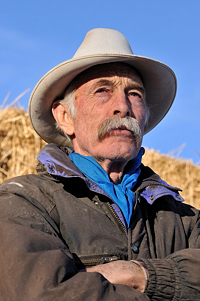
PROFILES: NEW MEXICANS YOU SHOULD KNOW
TURNING THE PAGE
Story and Photography by Tim Keller
ARCHIE WEST:
The Last Stockman on the Turquoise Trail
ARCHIE WEST HAS LIVED IN THE SAME HOUSE since 1943. Before leaving the family at the ranch to move full-time into his artist studio on Canyon Road in Santa Fe, Archie’s father, painter Hal West, married an Ohio schoolteacher and raised a family at Lone Butte, on the Turquoise Trail 20 miles south of the Santa Fe Plaza. While brother Jerry followed their father’s footsteps to become a renowned painter, Archie became the family’s lone cattleman.
At nineteen, Archie befriended a new neighbor over the hill: eastern newspaperman Jack Schaeffer had moved his family west after reaping a windfall when his novel Shane was turned into a movie. At Lone Butte, Schaeffer started a new series of magazine stories which grew into another novel, in 1963, called Monte Walsh. In the preface to the 1980 edition, Schaeffer wrote, “...fresh in my mind was the fact that among our nearest New Mexican neighbors was a young man named Archie West who to my mind was (and still is) in many respects, certainly in appearance and temperament and cattle-country capability and simple human decency, precisely my Monte Walsh.” The novel has been made into a film twice, with Monte portrayed by both Lee Marvin and Tom Sellack.
Turning 72 in 2009, Archie West is well-known around Santa Fe. Playing his Martin 0-15 mahogany guitar, bought in 1955, he sings old cowboy songs onstage as a guest of such beloved local acts as Bill Hearne, the Santa Fe All-Stars and Archie’s own nephew, Joe West. When he climbs off the stage, you’ll find Archie on the dance floor. Down Highway 14 in Madrid, Michael Roedel recognized a photograph of Archie on a website and posted this comment: “Archie’s an icon here and loved by all the women. I wish my girlfriend would want to dance with me as much as she wants to dance with him.”
Q: What did you do prior to entering the cattle business?
A: I graduated from Santa Fe High School in 1956. I was a couple years at the university (UNM) and a couple of years of freedom, then comes the notice and two years active service in the Army.
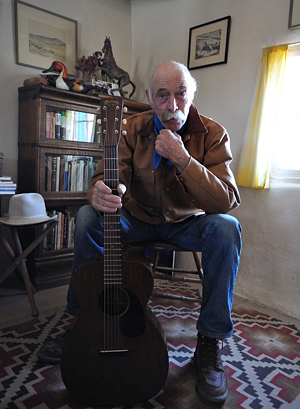
How did you get started in cattle?
When I got out of the Army at the end of 1962, I’d saved my money and the first thing I did to get back, I bought me some heifers from my Uncle Gene. A couple years later I took out an FHA loan to buy out my cousin’s stock when he moved to Wyoming. That took me close to 150 head of cattle. I never had ambition for more. I haven’t bought another since then.
When you started, did you lease land?
Oh yeah, absolutely. I couldn’t have afforded to buy land for cattle in the 1960s. Probably would have been possible for my dad, say 1940s, to pay for land because there was still land available for a dollar-and-a-half an acre.
The amount of land you leased, were you chasing your cattle around on horseback?
Oh, in the beginning it was certainly horseback. What we see around us today didn’t exist. I don’t ride from here anymore, but back then my cows were over here in the Cerrillos hills and it was all open country. It was easy to ride from here to Cerrillos. There was a pretty good spread in those times because I wasn’t feeding cows until I got them paid for. I haven’t ridden to Cerrillos in years.
How did you make a living on fewer than 150 cows?
Well, before I married, the cows were paying their way and I was able to make what money I needed, which wasn’t a heck of a lot. And I broke horses and worked on ranches, day work. I wasn’t a full-time employee, but a lot of that work went on for months. Eldorado, that was a ranch back then. And Jarrett’s. I worked some on the San Cristóbal. I didn’t get very far from home.
Do you own a 4-wheeler (ATV) now?
Well, a 4-wheel-drive pickup. (Archie drives a 1982 Chevy pickup.) No, no, this country may be 4-wheelable, but there’s a lot of it you just couldn’t get through, deep long arroyos. I see no advantage to it. Then there’s the smell and the noise. No, it just wouldn’t work.
You were approached to be the subject of a magazine article in the early 1960s but said no; why the change now?
Well, forty years can kind of change your attitude, maybe, a feeling you had at an embryonic stage, too tender to have that billed. It matters less to me now than it did then. Everything was so idyllic. First of all, at that age, 24! Everything was so right, and sacred, you didn’t want to harp about it, or show it off, or even have attention brought to it.
What’s changed?
An awful lot of the country that I have run cows on, I am the last stockman. This land has been grazed for hundreds of years. To be the last one grazing on this piece of earth, it’s a melancholy subject. Most of the country I’ve run cows on, it’s all houses now and will never be what it was again. There may be somebody with a horse in their back yard, but it will never be open grazing land again.
©2009, 2018 Tim Keller
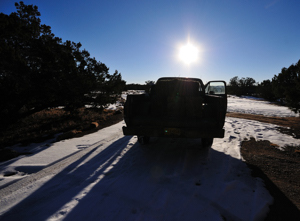
Archie starting out in the morning
|
|